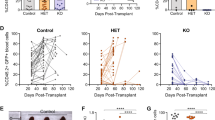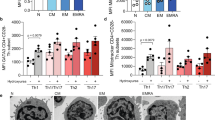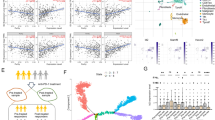Abstract
Bcl11b/Rit1 is involved in T-cell development and undergoes chromosomal rearrangements in human T-cell leukemias. Thymocytes of Bcl11b−/− newborn mice exhibit apoptosis at a certain developmental stage when thymocytes re-enter into the cell-cycle. Here, we show that Bcl11b-knockdown T-cell lines, when exposed to growth stimuli, exhibited apoptosis at the S phase with concomitant decreases in a cell-cycle inhibitor, p27 and an antiapoptotic protein, Bcl-xL, owing to transcriptional repression. This repression was a likely consequence of the impairment of Sirt1, a nicotinamide adenine dinucleotide-dependent deacetylase associating with Bcl11b. Activation of the apoptotic process cleaved the mediator protein, Claspin, and inhibited phosphorylation of cell-cycle checkpoint kinase 1 (Chk1) that plays a central role in sensing and responding to incomplete replication. Bcl11b−/− thymocytes also failed to phosphorylate Chk1 when UV irradiated. These results implicate Bcl11b in the remedy for DNA replication stress and maintenance of genomic integrity.
This is a preview of subscription content, access via your institution
Access options
Subscribe to this journal
Receive 50 print issues and online access
$259.00 per year
only $5.18 per issue
Buy this article
- Purchase on Springer Link
- Instant access to full article PDF
Prices may be subject to local taxes which are calculated during checkout






Similar content being viewed by others
References
Andegeko Y, Moyal L, Mittelman L, Tsarfaty I, Shiloh Y . (2001). Nuclear retention of ATM at sites of DNA double strand breaks. J Biol Chem 276: 38224–38230.
Abraham RT . (2001). Cell-cycle checkpoint signaling through the ATM and ATR kinases. Genes Dev 15: 2177–2196.
Alam A, Cohen LY, Aouad S, Sekaly RP . (1999). Early activation of caspases during T lymphocyte stimulation results in selective substrate cleavage in nonapoptotic cells. J Exp Med 190: 1879–1890.
Avram D, Fields A, Pretty On Top K, Nevrivy DJ, Ishmael JE, Leid M . (2000). Isolation of a novel family of C2H2 zinc finger proteins implicated in transcriptional repression mediated by chicken ovalbumin upstream promoter transcription factor (COUP-TF) orphan nuclear receptors. J Biol Chem 275: 10315–10322.
Bagheri-Yarmand R, Talukder AH, Wang RA, Vadlamudi RK, Kumar R . (2004). Metastasis-associated protein 1 deregulation causes inappropriate mammary gland development and tumorigenesis. Development 131: 3469–3479.
Bartkova J, Horejsi Z, Koed K, Kramer A, Tort F, Zieger K et al. (2005). DNA damage response as a candidate anti-cancer barrier in early human tumorigenesis. Nature 434: 864–870.
Brunet A, Sweeney LB, Sturgill JF, Chua KF, Greer PL, Lin Y et al. (2004). Stress-dependent regulation of FOXO transcription factors by the SIRT1 deacetylase. Science 303: 2011–2015.
Chen Y, Sanchez Y . (2004). Chk1 in the DNA damage response: conserved roles from yeasts to mammals. DNA Repair (Amst) 3: 1025–1032.
Cismasiu VB, Adamo K, Gecewicz J, Duque J, Lin Q, Avram D . (2005). BCL11B functionally associates with the NuRD complex in T lymphocytes to repress targeted promoter. Oncogene 24: 6753–6764.
Clarke CA, Bennett LN, Clarke PR . (2005). Cleavage of Claspin by caspase-7 during apoptosis inhibits the Chk1 pathway. J Biol Chem 280: 35337–35345.
Di Cristofano A, De Acetis M, Koff A, Cordon-Cardo C, Pandolfi PP . (2001). Pten and p27KIP1 cooperate in prostate cancer tumor suppression in the mouse. Nat Genet 27: 222–224.
Eguchi-Ishimae M, Eguchi M, Ishii E, Miyazaki S, Ueda K, Kamada N et al. (2001). Breakage and fusion of the TEL (ETV6) gene in immature B lymphocytes induced by apoptogenic signals. Blood 97: 737–743.
Fero ML, Randel E, Gurley KE, Roberts JM, Kemp CJ . (1998). The murine gene p27Kip1 is haplo-insufficient for tumor suppression. Nature 396: 177–180.
Fero ML, Rivkin M, Tasch M, Porter P, Carow CE, Firpo E et al. (1996). A syndrome of multiorgan hyperplasia with features of gigantism, tumorigenesis, and female sterility in p27(Kip1)-deficient mice. Cell 85: 733–744.
Flatten K, Dai N, Vroman BT, Loegering D, Erlichman C, Karnitz LM et al. (2005). The role of checkpoint kinase 1 in sensitivity to topoisomerase I poisons. J Biol Chem 280: 14349–14355.
Gorgoulis VG, Vassiliou LV, Karakaidos P, Zacharatos P, Kotsinas A, Liloglou T et al. (2005). Activation of the DNA damage checkpoint and genomic instability in human precancerous lesions. Nature 434: 907–913.
Gounari F, Aifantis I, Khazaie K, Hoeflinger S, Harad N, Taketo MM et al. (2001). Somatic activation of β-catenin bypasses pre-TCR signaling and TCR selection in thymocyte development. Nat Immunol 2: 863–969.
Hoeppner DJ, Hengartner MO, Schnabel R . (2001). Engulfment genes cooperate with ced-3 to promote cell death in Caenorhabditis elegans. Nature 412: 202–206.
Inoue J, Kanefuji T, Okazuka K, Watanabe H, Mishima Y, Kominami R . (2006). Expression of TCRαβ partly rescues developmental arrest and apoptosis of αβT cells in Bcl11b−/− mice. J Immunol 176: 5871–5879.
Kastan MB, Bartek J . (2004). Cell-cycle checkpoints and cancer. Nature 432: 316–323.
Kiyokawa H, Kineman RD, Manova-Todorova KO, Soares VC, Hoffman ES, Ono M et al. (1996). Enhanced growth of mice lacking the cyclin-dependent kinase inhibitor function of p27(Kip1). Cell 85: 721–732.
Lam MH, Liu Q, Elledge SJ, Rosen JM . (2004). Chk1 is haploinsufficient for multiple functions critical to tumor suppression. Cancer Cell 6: 45–59.
Levine AJ, Feng Z, Mak TW, You H, Jin S . (2006). Coordination and communication between the p53 and IGF-1-AKT-TOR signal transduction pathways. Genes Dev 20: 267–275.
Lin SY, Li K, Stewart GS, Elledge SJ . (2004). Human Claspin works with BRCA1 to both positively and negatively regulate cell proliferation. Proc Natl Acad Sci USA 101: 6484–6489.
Liu Q, Guntuku S, Cui XS, Matsuoka S, Cortez D, Tamai K et al. (2000). Chk1 is an essential kinase that is regulated by Atr and required for the G(2)/M DNA damage checkpoint. Genes Dev 14: 1448–1459.
Motoyama N, Wang F, Roth KA, Sawa H, Nakayama K, Nakayama K et al. (1995). Massive cell death of immature hematopoietic cells and neurons in Bcl-x-deficient mice. Science 267: 1506–1510.
Motta MC, Divecha N, Lemieux M, Kamel C, Chen D, Gu W et al. (2004). Mammalian SIRT1 represses forkhead transcription factors. Cell 116: 551–563.
Nagel S, Kaufmann M, Drexler HG, MacLeod RA . (2003). The cardiac homeobox gene NKX2-5 is deregulated by juxtaposition with BCL11B in pediatric T-ALL cell lines via a novel t(5;14)(q35.1q32.2). Cancer Res 63: 5329–5334.
Nakayama K, Ishida N, Shirane M, Inomata A, Inoue T, Shishido N et al. (1996). Mice lacking p27(Kip1) display increased body size, multiple organ hyperplasia, retinal dysplasia, and pituitary tumors. Cell 85: 707–720.
Nakayama K, Nagahama H, Minamishima YA, Miyake S, Ishida N, Hatakeyama S et al. (2004). Skp2-mediated degradation of p27 regulates progression into mitosis. Dev Cell 6: 661–672.
Przybylski GK, Dik WA, Wanzeck J, Grabarczyk P, Majunke S, Martin-Subero JI et al. (2005). Disruption of the BCL11B gene through inv(14)(q11.2q32.31) results in the expression of BCL11B-TRDC fusion transcripts and is associated with the absence of wild-type BCL11B transcripts in T-ALL. Leukemia 19: 201–208.
Reddien PW, Cameron S, Horvitz HR . (2001). Phagocytosis promotes programmed cell death in Celegans. Nature 412: 198–202.
Sakata J, Inoue J, Ohi H, Kosugi-Okano H, Mishima Y, Hatakeyama K et al. (2004). Involvement of V(D)J recombinase in the generation of intragenic deletions in the Bcl11b/Bcl11b tumor suppressor gene in γ-ray-induced thymic lymphomas and in normal thymus of the mouse. Carcinogenesis 25: 1069–1075.
Sanchez Y, Wong C, Thoma RS, Richman R, Wu Z, Piwnica-Worms H et al. (1997). Conservation of the Chk1 checkpoint pathway in mammals: linkage of DNA damage to Cdk regulation through Cdc25. Science 277: 1497–1501.
Satterwhite E, Sonoki T, Willis TG, Harder L, Nowak R, Arriola EL et al. (2001). The BCL11 gene family: involvement of BCL11A in lymphoid malignancies. Blood 98: 3413–3420.
Senawong T, Peterson VJ, Avram D, Shepherd DM, Frye RA, Minucci S et al. (2003). Involvement of the histone deacetylase SIRT1 in chicken ovalbumin upstream promoter transcription factor (COUP-TF)-interacting protein 2-mediated transcriptional repression. J Biol Chem 278: 43041–43050.
Shinbo T, Matsuki A, Matsumoto Y, Kosugi S, Takahashi H, Niwa O et al. (1999). Allelic loss mapping and physical delineation of a region harboring a putative thymic lymphoma gene on chromosome 12. Oncogene 12: 4131–4136.
Takai H, Tominaga K, Motoyama N, Minamishima YA, Nagahama H, Tsukiyama T et al. (2000). Aberrant cell-cycle checkpoint function and early embryonic death in Chk1(−/−) mice. Genes Dev 14: 1439–1447.
van de Wetering M, de Lau W, Clevers H . (2002). WNT signaling and lymphocyte development. Cell 109: S13–S19.
Wakabayashi Y, Inoue J, Takahashi Y, Matsuki A, Kosugi-Okano H, Shinbo T et al. (2003a). Homozygous deletions and point mutations of the Bcl11b/Bcl11b gene in γ-ray induced mouse thymic lymphomas. Biochem Biophys Res Commun 301: 598–603.
Wakabayashi Y, Watanabe H, Inoue J, Takeda N, Sakata J, Mishima Y et al. (2003b). Bcl11b is required for differentiation and survival ofαβ T lymphocytes. Nat Immunol 4: 533–539.
Walworth N, Davey S, Beach D . (1993). Fission yeast chk1 protein kinase links the rad checkpoint pathway to cdc2. Nature 363: 368–371.
Zhao H, Watkins JL, Piwnica-Worms H . (2002). Disruption of the checkpoint kinase 1/cell division cycle 25A pathway abrogates ionizing radiation-induced S and G2 checkpoints. Proc Natl Acad Sci USA 99: 14795–14800.
Zhou BB, Bartek J . (2004). Targeting the checkpoint kinases: chemosensitization versus chemoprotection. Nat Rev Cancer 4: 216–225.
Zou L, Elledge SJ . (2003). Sensing DNA damage through ATRIP recognition of RPA-ssDNA complexes. Science 300: 1542–1548.
Acknowledgements
We thank O Niwa and A Balmain for helpful comments on the paper. This work was supported by grants-in-aid for Cancer Research from the Ministries of Education, Science, Art and Sports, and of Health and Welfare of Japan.
Author information
Authors and Affiliations
Corresponding author
Additional information
Supplementary Information accompanies the paper on the Oncogene website (http://www.nature.com/onc).
Supplementary information
Rights and permissions
About this article
Cite this article
Kamimura, K., Mishima, Y., Obata, M. et al. Lack of Bcl11b tumor suppressor results in vulnerability to DNA replication stress and damages. Oncogene 26, 5840–5850 (2007). https://doi.org/10.1038/sj.onc.1210388
Received:
Revised:
Accepted:
Published:
Issue Date:
DOI: https://doi.org/10.1038/sj.onc.1210388
Keywords
This article is cited by
-
miR-214 is Stretch-Sensitive in Aortic Valve and Inhibits Aortic Valve Calcification
Annals of Biomedical Engineering (2019)
-
BCL11A overexpression predicts survival and relapse in non-small cell lung cancer and is modulated by microRNA-30a and gene amplification
Molecular Cancer (2013)
-
The role of BCL11B in hematological malignancy
Experimental Hematology & Oncology (2012)
-
Analysis of the expression pattern of the BCL11B gene and its relatives in patients with T-cell acute lymphoblastic leukemia
Journal of Hematology & Oncology (2010)
-
Molecular mechanisms of HIV-1 persistence in the monocyte-macrophage lineage
Retrovirology (2010)



